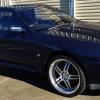LED Parkers
Announcements
-
Similar Content
-
Latest Posts
-
By TurboTapin · Posted
Well some mostly good news and some slight bad news. Good news is cylinder 6 did in fact only require a honing and I'm good to run my 86.5mm pistons again. I should also get the block back by end of week. Bad news, had a few surprises pop up. First, main and rod bearings were trashed. No sign of any heat damage. I knew right away what caused this... I had not packed my oil pump originally and spent a lot more time than I would have liked cranking the motor to get oil pressure. It sounded fine once started so I chucked it up to luck and forgot about it. Luckily rod and crank are fine and just need new bearings. Engine builder agreed that this was the cause. Another surprise that carbon covered up very well that I didn't catch, something got sucked up and went through cylinder 1, 2 and 3. Luckily this was no cause for concern, just needed a bit of cleaning up. Valves look fine but he will vacuum test the head this week to confirm. I'm presuming this was something left over from welding my intercooler piping, but we'll never know. I'm going to thoroughly reclean everything. So all in all, happy the motor is fine, and I'll get it back much sooner than expected. I'll also be taking the time to convert my WMI system over to direct port. I'll snap some pictures of that when the parts come in. -
I understand, thanks. Yeah I wouldn't want the car to tip over, I'll try and use the sills, I don't want to risk smashing the chassis rails. I ordered some rubber pucks that have a hopefully big enough slotting. If the front right gives me trouble I can always just make a wood block. I'll measure and inspect the sills closer once I actually take the car up. I hope so, but the rubber blocks I had in hand so far were pretty damn firm, if they are that hard they won't give much way. I'll let you know what happens. Angle grinding rubber isn't one of my favorite tasks. I'll probably start a build thread soon, for my own documentation and "log" as well as sharing what's going on with the car.
-
Kinda something I have been thinking about. To be honest, we bought it already driving like that. So there's no telling how long it actually has been driving like this. Hopefully damage is too bad when we drop the pan. I am having a hard time finding a site that sells the solenoid for the 5 speed auto, do you have any suggestions?
-








Recommended Posts
Create an account or sign in to comment
You need to be a member in order to leave a comment
Create an account
Sign up for a new account in our community. It's easy!
Register a new accountSign in
Already have an account? Sign in here.
Sign In Now